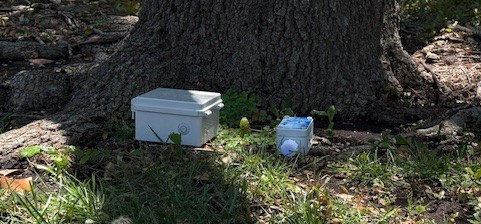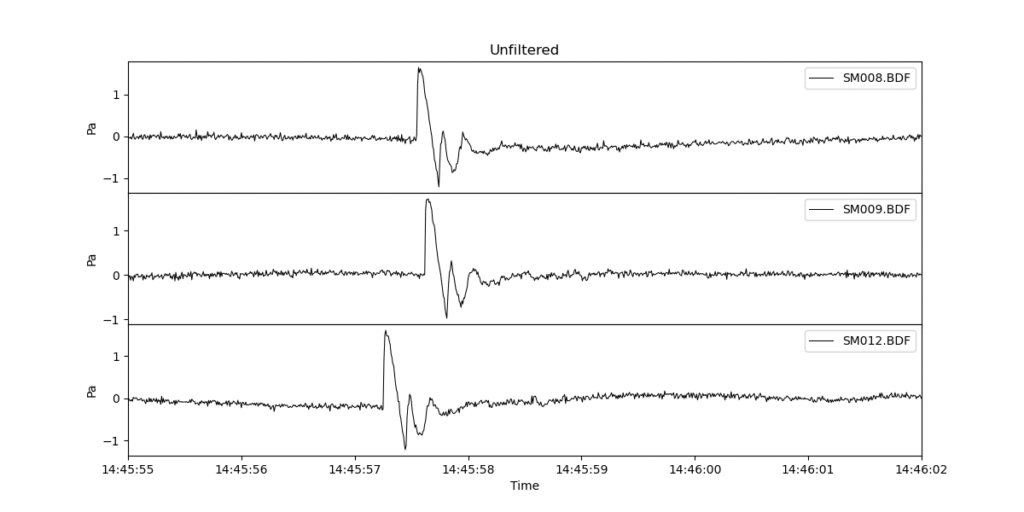Our senses offer us the most immediate means of perceiving and understanding the physical world, yet they are limited in scope. Many phenomena lie beyond the range of our perception and require specialized instruments to detect and understand. In the audible realm, our ears are sensitive to acoustic waves (pressure waves in the atmosphere) at frequencies from 20 Hz – 20 kHz. At frequencies below 20 Hz, acoustic waves are called infrasound, and they are generated by a variety of natural and manmade sources and can travel long distances.
In some ways, it’s fortunate that we can’t hear infrasound—otherwise, we’d be constantly surrounded by a low-frequency rumble from the oceans, comparable in volume to the background noise inside a moving vehicle. Such constant noise would make it harder to detect quieter sounds critical to our awareness and survival. However, our lack of perception of this inaudible realm also means we miss out on a rich source of acoustic information. Infrasound carries valuable insights into both natural and anthropogenic events and, remarkably, offers a unique window into the dynamic conditions of the atmosphere through which it travels.
To detect infrasound, we use instruments called microbarometers—highly sensitive devices capable of measuring pressure fluctuations of less than a Pascal within the infrasound range. Because traditional microbarometers are only used for niche applications, they are expensive, typically costing several thousand dollars each and produced by only a few manufacturers. Taking inspiration from a group at Boise State working on volcano infrasound, which began creating custom sensors using MEMS components and the Arduino platform, Chris Hayward—a research scientist in my group—began developing our own sensor, the Sapphire sensor, shortly after I joined SMU. Since then, we’ve built 500 sensors and deployed them in a wide variety of locations over the past few years!
Our Sapphire sensors are low-cost and easy to deploy, enabling experiments that would be difficult or impossible with more expensive equipment. Their affordability and sheer number allow us to explore a wide range of acoustic phenomena in unique ways. We’ve deployed them in a variety of fascinating locations and recorded a diverse set of signals—from geysers and rivers to rocket launches, quarry blasts, and even the reentry of space probes. We’ve also captured infrasound from an 18-wheeler truck modified into a massive subwoofer, bridge resonances, and cannon fire.
The dense spatial coverage made possible by our large pool of sensors allows us to make high-resolution measurements, revealing fine details in how infrasound propagates. This has enabled us to investigate how infrasonic wavefields evolve with azimuth and distance from different sources—particularly useful in understanding signal behavior in complex urban environments. During the total solar eclipse in Dallas in April 2024, we used the sensors to study how signal propagation changed in response to rapid shifts in atmospheric boundary layer properties caused by the sudden loss of solar radiation. We’ve also deployed dense networks of Sapphires to explore the propagation of bridge resonance signals in an urban environment, and the evolution of explosion signals with distance in different settings.
Sometimes, it’s not the dense sensor coverage that’s the biggest advantage—it’s the simplicity of quickly deploying a few sensors to capture unexpected or opportunistic events. Because Sapphire sensors are compact and easy to travel with, we often bring them along on trips to interesting locations. For example, Chris Hayward recorded infrasound from the Nine O’Clock Gun—an 1800s-era cannon fired nightly in Stanley Park—by placing a Sapphire on his hotel balcony during the SSA Photonic Seismology workshop in Vancouver last year. Cathy Chickering took Sapphires to Niagara Falls and recorded infrasound from the waterfalls at multiple vantage points.
I often now travel with a Sapphire myself, just in case an interesting measurement opportunity arises, and I encourage others in the group to pack one or two whenever they travel somewhere notable.
The photo below shows two versions of our sensor—the standard Sapphire and the larger Sapphire XL—next to a tree trunk for scale. While the regular Sapphire runs for 3–4 weeks on four AA batteries, the Sapphire XL uses D-cell batteries and can operate continuously for several months.

As an example of the kind of signals we capture, the figure below shows data recorded by a Sapphire during the hypersonic reentry of OSIRIS-REx (a NASA capsule that collected samples from the asteroid Bennu). The shockwave it generated produced a classic ‘N’-shaped waveform, characteristic of high-speed atmospheric entries.

We’re currently working on several publications using Sapphire data, and have a large experiment coming up this summer in Norway where we’ll use 225 sensors (the largest deployed for a single experiment yet). Stay tuned for the details of these papers for the scientific publications and feel free to reach out to me if you’re interested in using the Sapphires for joint experiments!